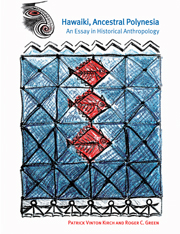Book contents
- Frontmatter
- Contents
- List of figures
- List of tables
- Preface
- List of language abbreviations
- Prologue: on historical anthropology
- Part I The phylogenetic model: theory and method
- 1 The phylogenetic model in historical anthropology
- 2 Methodologies: implementing the phylogenetic model
- 3 Polynesia as a phylogenetic unit
- Part II Rediscovering Hawaiki
- Epilogue: on history, phylogeny, and evolution
- Notes
- Glossary of terms
- References
- Subject Index
- Index of Proto Polynesian Reconstructions
3 - Polynesia as a phylogenetic unit
Published online by Cambridge University Press: 06 January 2010
- Frontmatter
- Contents
- List of figures
- List of tables
- Preface
- List of language abbreviations
- Prologue: on historical anthropology
- Part I The phylogenetic model: theory and method
- 1 The phylogenetic model in historical anthropology
- 2 Methodologies: implementing the phylogenetic model
- 3 Polynesia as a phylogenetic unit
- Part II Rediscovering Hawaiki
- Epilogue: on history, phylogeny, and evolution
- Notes
- Glossary of terms
- References
- Subject Index
- Index of Proto Polynesian Reconstructions
Summary
The Polynesian cultures derive from a common source; they are members of a single cultural genus that has filled in and adapted to a variety of local habitats.
sahlins 1958:ix… in many instances race, language, and culture do coincide to establish an authentic ethnic coherence. Polynesia seems to be such an instance.
goldman 1970:xxiiiSpace, time, and content must be the prime definitional axes for any phylogenetic entity in the kind of historical anthropology for which this book is an extended argument. We insist that the issue itself requires multiple perspectives: linguistic, ethnological, biological, and archaeological. Having laid out specific methods and procedures by which a phylogenetic model can be promulgated, we now scrutinize the Polynesian case, searching for congruence among independent lines of evidence to test whether Polynesia meets the criteria for a discrete “segment of cultural history.” We will demonstrate, first that the linguistic subgrouping of Polynesian languages is closely mirrored by systemic ethnographic patterns across Polynesian societies, and second that there is biological coherence as well among the various Polynesian populations.
It is also essential for us to define precisely what is meant by “Ancestral Polynesian” culture and societies. This is not some vague notion of a putative cultural stage loosely corresponding to a set of reconstructed Proto Polynesian words. On the contrary, we will identify a discrete group of archaeological sites and their artifactual assemblages, dating to the second half of the first millennium BC, as the physical manifestations of those Ancestral Polynesian societies and communities that flourished in the Tonga–Samoa homeland region prior to the diaspora that ultimately put Polynesians on virtually every habitable island in the vast eastern Pacific.
- Type
- Chapter
- Information
- Hawaiki, Ancestral PolynesiaAn Essay in Historical Anthropology, pp. 53 - 92Publisher: Cambridge University PressPrint publication year: 2001



